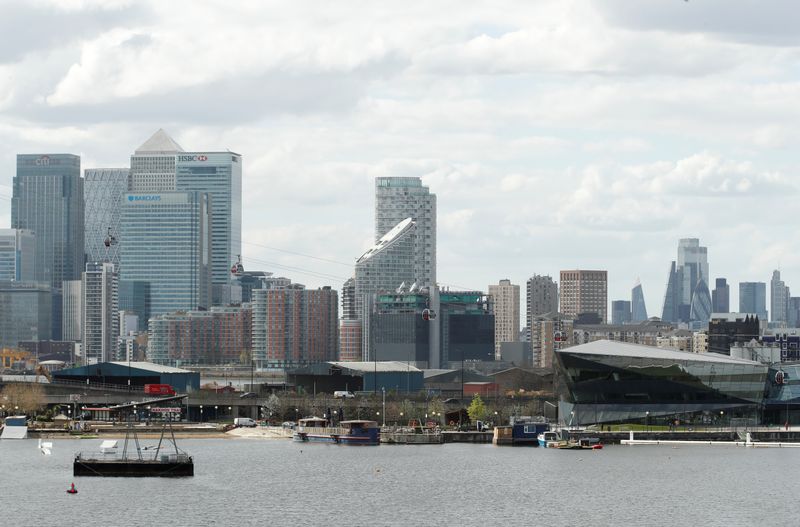(This story had been refiled to add missing words in paragraph 16 of story first published April 9.)
LONDON (Reuters) – Will be it a U? A V? Maybe a W? Predictions for economic recovery after coronavirus-linked lockdowns are throwing up a medley of letters to indicate whether we can expect a bounceback, a slow-burn recovery or relapse.
Of more than 50 economists polled by Reuters, some forecast the world economy will shrink as much as 6% in 2020. The other extreme was a prediction for 0.7% growth. The average was a 1.2% contraction.
Carsten Brzeski, global head of macro at ING Research, dubbed the picture “a virus-driven ice age”.
“It is an abrupt stop of economic activity, from 100 to zero in just a few days or weeks,” he said, adding that made it extremely difficult to forecast the outlook.
Here are some scenarios debated.
1. “V”
The best case outcome: when a growth plunge is followed by an equally sharp recovery.
The April-June GDP contraction will likely be on a scale not seen for decades. But fiscal and monetary stimulus – over $10 trillion and counting – could aid an equally swift rebound.
Ross Walker, co-head of global economics at NatWest Markets, reckons the scale of economic decline expected this quarter implies “a sizeable rebound in Q3 and Q4 as businesses re-open”.
Graphic – V-shaped recovery: https://fingfx.thomsonreuters.com/gfx/editorcharts/qmypmxgkvra/eikon.png
For an interactive version of the below graphic, click here https://reut.rs/2RodaZf.
2. “U”
When recovery takes more than a couple of quarters. Because economies have suffered a faster and deeper contraction than in 2008-09, this may be the likeliest outcome.
U is the base case for ING’s Brzeski, who notes the lockdowns’ impact will last for a while after they are lifted.
“Easing of the lockdown measures will be gradual, social distancing will continue and the tourist industry will likely continue to suffer,” Brzeski said.
Graphic – U-shaped recovery: https://fingfx.thomsonreuters.com/gfx/editorcharts/yzdpxkravxe/eikon.png
For an interactive version of the below graphic, click here https://reut.rs/34kX9IT.
3. “W”
Double-dip – if the easing of lockdown restrictions initially boosts activity but the effects of unemployment and corporate bankruptcies then start to filter through.
This may happen also if new coronavirus cases emerge as has been the case in some Asian countries.
“Our bias is the recovery looks less V- or U-shaped but more W-shaped, with rolling lockdowns for the rest of the year a big risk,” Nomura said.
Graphic – W-shaped recovery: https://fingfx.thomsonreuters.com/gfx/editorcharts/ygdpzbwjpwa/eikon.png
For an interactive version of the below graphic, click here https://reut.rs/2xfo9gI.
4. “L”
When growth plunges and does not recover for some time.
For this to occur, the global coronavirus tally needs to continue rising, forcing protracted lockdowns.
That scenario looks unlikely, given Wuhan, the Chinese city where the virus emerged, has ended lockdowns after just over two months.
But L-shaped outcomes may be a risk for those emerging markets less able to engage big stimulus and often rely on commodity exports.
Graphic – L-shaped recovery: https://fingfx.thomsonreuters.com/gfx/editorcharts/yzdvxknapxe/eikon.png
For an interactive version of the below graphic, click here https://reut.rs/2VlbAIW.
5. SWOOSH
“Neither L nor U nor V, will do. Instead, we look for a tick mark-style profile,” Berenberg economist Florian Hense said.
That implies a sharp downturn, then gradual recovery as lockdowns are eased more gently than they were imposed.
AXA Investment Managers group chief economist Gilles Moec pictures a “swoosh” shape akin to the Nike sports brand logo.
“With consumer spending possibly impaired by a higher propensity to save and serious potential curbs on investment, we think the likeliest scenario is for the world economy’s rebound post lockdown to be quite soft,” Moec said.
Graphic – Tick shape recovery: https://fingfx.thomsonreuters.com/gfx/mkt/jbyvremdpeo/tick.png
(Reporting by Dhara Ranasinghe; Additional reporting by Karin Strohecker; Graphics by Ritvik Carvalho; Editing by Sujata Rao and Susan Fenton)






















